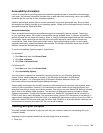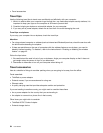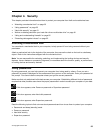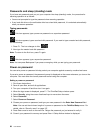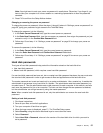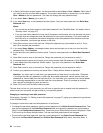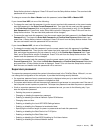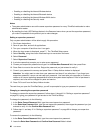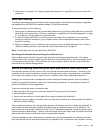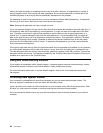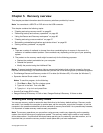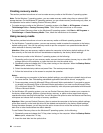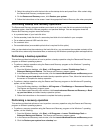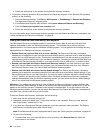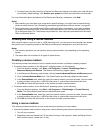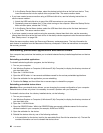
3. Follow step 11 and step 12 in “Setting a supervisor password” on page 60 to remove your supervisor
password.
Hard disk security
To protect passwords from unauthorized security attacks, several of the latest technologies and algorithms
are integrated into UEFI BIOS and hardware design of ThinkPad notebooks.
To maximize security, do the following:
1. Set a power-on password as well as a hard disk password for your internal solid state drive or hard disk
drive. Refer to the procedures in “Power-on password” on page 56 and “Hard disk passwords” on page
57
. For security, a longer password is recommended.
2. If a Disk Encryption hard disk drive and Encryption solid state drive is installed in your computer,
be sure to protect the contents of your computer memory from unauthorized access by use of drive
encryption software.
3. Before you dispose of, sell, or hand over your computer, be sure to delete data stored on it. Refer to
“Notice on deleting data from your hard disk drive or solid state drive” on page 61.
Note: The hard disk drive can be protected by UEFI BIOS.
Disk Encryption hard disk drive and Encryption solid state drive
Some models contain the Disk Encryption hard disk drive or Encryption solid state drive. This feature
helps to protect your computer against security attacks on media, NAND ash or device controllers by use
of a hardware encryption chip. For the efcient use of the encryption feature, be sure to set a Hard disk
passwords for the internal storage device.
Notice on deleting data from your hard disk drive or solid state drive
As computers spread into every corner of life, they process more and more information. The data on your
computer, some of which is sensitive, is stored on a storage device, either a hard disk drive or solid state
drive. Before you dispose of, sell, or hand over your computer, make sure to delete data stored on it.
Handing your computer over to someone else without deleting the loaded software, such as operating
systems and application software, might even violate license agreements. You are advised to check the
terms and conditions of those agreements.
There are methods that seem to delete the data:
• Move the data to the recycle bin, and then choose the Empty recycle bin command.
• Use the Delete command.
• Format your hard disk drive or solid state drive, using the software for initializing it.
• Using the recovery program, provided by Lenovo, bring the hard disk drive or the solid state drive back to
the factory default settings.
These operations, however, only change the le allocation of the data; they do not delete the data itself. In
other words, the data retrieval processing is disabled under an operating system such as Windows. The
data is still there, even though it seems to be lost. Thus, it is sometimes possible to read the data by use of
special software for data recovery. There is a risk that people of bad faith might read and misuse the critical
data on hard disk drives or solid state drives for unexpected purposes.
To prevent leakage of data, it becomes very important that you take responsibility for deleting all the data
from the hard disk drive or solid state drive when you dispose of, sell, or hand over your computer. You can
Chapter 4. Security 61



